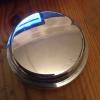
All Torque. (Camshafts)
#16

Posted 20 February 2013 - 06:26 PM
#17

Posted 20 February 2013 - 09:09 PM
The running order is looking strong for the SW5 at the moment, with no real info on the 274SP. I can't read the numbers well enough to know the differences they make either
It's on my "to do" list, honest.
So can anyone enlighten me to the differences between say,
SW5-07
Kent 274SP
Piper BP255
AC Dodds offerings
Are the Minispares / Minisport cams worth a look, from experience?
#18

Posted 21 February 2013 - 12:30 AM
I have used the SW5 in a 1030cc build. Even using an MG metro head with stupidly big ports, it made great torque all the way from idle to right up the top end. It peaked at 52BHP@wheels at 5700 but was still making 50 bhp at 6700 so it hung on well. Highish compression helped with this.
I'd recommend the SW5 much more highly for an auto application (and injection come to that!). instant response and a big fat torque curve is what you need, absolutely no point in having the engine pull best at revs you cant achieve in the first 3 gears. And, as shown by the above figures the SW5 is more than capable at the top end too so you have the ability to rev out in top gear, if geared accordingly. As somebody else mentioned, you need to factor in the convertor slip when working out your final drive ratio. A 3.44 will be doing approx 6250rpm at 100mph and 4300 at 70mph with a manual box, which in my opinion is unbearable if you use motorways at all often, even for short distances. So with an auto box i would say you would be looking at atleast a 2.9 to give even reasonable cruising. I've always fancied doing a tuned auto myself so i'm very interested to see how this turns out! Should be a proper little go-kart!
#19

Posted 21 February 2013 - 12:44 AM
Thanks for the input!
The 274SP is the scatter pattern variety of the 274(which is the injection shaped cam) hence the funny durations I think. It's marketed as a high torque cam but as such a niche sale point I'm having trouble getting any real info on it.
Differences in bold.
274
MD274 Camshaft Sports Injection
Applications Sports Injection Power Band 1000-6000 Cam Lift(mm) 7.23mm Inlet / 7.13mm Exhaust Valve Lift(mm) 8.85mm Inlet / 8.71mm Exhaust Duration 284 Deg Inlet/ 274 Deg Exhaust Timing 12/56 69/25 Full Lift Inlet 112 Deg ATDC VC (mm) 0.40mm Inlet/Exhaust LTDC 0.58mm Inlet
Retainer Material Steel Pulley Material Steel VSType Double VSInstalled Height 36.0mm VSNomSolid Height 19.0mm VSNominal ID 16.0mm VSDiameter 29.2mm BHP Gain N/A LinkRefAddInfo
N/A
274SP
MD274SP Camshaft High Torque
Applications High Torque Power Band 1500 - 6500 Cam Lift(mm) 7.23mm Inlet/ 7.13mm Exhaust Valve Lift(mm) 8.85mm Inlet / 8.71mm Exhaust Duration 248 Deg Inlet/ 274 Deg Exhaust Timing 16/52 71/29 Full Lift Inlet 108 Deg ATDC VC (mm) 0.40mm Inlet/Exhaust LTDC 0.89mm Inlet
Retainer Material Steel Pulley Material Steel VSType Single VSInstalled Height 36.0mm VSNomSolid Height 23.0mm VSNominal ID 21.6mm VSDiameter 29.0mm BHP Gain N/A LinkRefAddInfo N/A
Regarding FD's the mini engine (on a sprite cam) before the box failed was putting out 52bhp at the wheel and would sit at about 85 on a 3.27 FD, no rev counter fitted at the time though and coming from performance bikes my 'ear' is a bit overtuned as 5k rpm is casual pull away revs
But that felt more like the car was out of go than out of revs.
Go kart is about what I'm hoping for, more than excitable enough around town and out in the lanes but capable on the long runs without feeling relegated to the inside lane.
#20

Posted 21 February 2013 - 12:46 AM
#21

Posted 21 February 2013 - 01:14 AM
The injection cam that i used had the second set of figures that you've quoted. I have a feeling they've mis-printed those first set and it is indeed the same cam......the lift figures are the same also. I've seen quite a few mis-printed cam figures on kent and piper websites etc. In fact if you look at the timing figures they do not add up to the duration as quoted, but are the same as for the other cam. What is different though is the Lobe centre angle. (the angle between the inlet and exhaust lobes) They widen this on the injection cams to give less valve overlap so that there is no hydrocarbon carryover into the catalytic converter, which will damage it. It also helps to improve low speed volumetric efficiency (torque) and better idle when using the relatively long timing on the exhaust.
Also +1 for ethel comments, i would highly recommend NOT using an aldon yellow. I don't believe it has a vac advance and is thereofre totally unsuitable for a road car, i.e. the timing will only be correct (even then only maybe) when the throttle is wide open......so race engines only then, where part throttle response and economy are not an issue. A correctly set up programmable ignition is the way to go.
#22

Posted 21 February 2013 - 08:49 AM
There much be someone using this cam out there somewhere, haha. It's listed as high torque where as the non scatter is shown as an injection cam. Some real world numbers would be great, I might drop Kent a line and see if they have any figures or even (shock) the right timings.
Okay so Aldon is out, where does that leave the ignition? Megajolt and... Is there anything else?
Good shout Ethel, I actually have some links to Austin America sites already where they detail tweaking the transmission and how to modify it but a more specific search could yield some info.
#23

Posted 21 February 2013 - 11:02 AM
1500rpm is too high.
Most of the above camshafts will not give you the results that you require, you need the power to be lower in the rev range than they can give.
Straight cut drops and C&P gear sets are available for automatics, you just need to know where to ask
As are uprated clutch plates to take the power.
#24

Posted 21 February 2013 - 11:09 AM
So your suggestion would be the SW5 also? It seems to be obvious choice thus far.
Why would 1500 be too high, I'm eager to understand more fully as from my driving experience under 1500rpm is only used for low speed manouvring and very sedate pull aways.
Didn't follow the bit about the crown wheel, but could you explain the advantages of using a different gearset also if you think the torque convertor (was mentioned earlier) would need any alteration.
I spoke to you via AMR a short while ago about the transmission upgrade, which included bands and clutch if I recall. This is the engine to accompany it, hopefully.
Edited by Skortchio, 21 February 2013 - 11:10 AM.
#25

Posted 21 February 2013 - 11:18 AM
Lock up would stop your engine from revving, so you wouldn't get away very easily
It simply would not rev
Yes of course I remember you
Crown wheel & pinion is the gear that can allow you to change your gear ratios.... it also has an effect on your stall speed, higher FD ratio will feel like a slightly "heavier" Mini and the engine will then need to do more work to get you going, therefore require more torque.
I have never used an SW5 camshaft in an automatic, I have my own camshaft cut to my spec for 1275 SPi/MPi or carb models...
I would suggest that you use an ECU as well, definately better for the bottom end power/torque.
#26

Posted 21 February 2013 - 11:21 AM
I can help you with a suitable torque convertor if you want a higher stall speed.
#27

Posted 21 February 2013 - 11:30 AM
Okay so the MJ or similar route is what you suggest on the ignition front?
Having driven the sprite engine with the 3.27 and now the metro engine with the 3.44, the metro does feel faster on aceleration but then it also has a 10bhp+ advantage over the spite as well.
Is there a way to overcome the 'lock up' and what is it exactly? The engine idles at about 1k rpm so soon as I hit the gas I'm part that point, at leat in my head.
Looking at various dyno charts the cams listed aren't anything short on power from idle they just don't really take off right away. The engine will still run before it comes 'on cam' surely?
I don't have experience in the subtleties of automatics which is why all the questions, sorry about that.
Would / Do the gear ratios need changing? Given I'm going to be gaining a good 20ft/lb of torque above the factory figures for the Metro engine I imagine the getting going won't be a big issue. But as suggested the 3.44 FD seems appropriate?
How does your cam measure up to the SW5 etc?
Obviously I have a keen interest in what is inside my engine but for the most part once it's bolted together as long as it does what I plan and lasts for the forseeable future I'm happy
#28

Posted 21 February 2013 - 11:33 AM
The 'stage 4' head is a bit cursory, given everyone appears to have a difference idea about what a stage dicates.
Big valves, ported and polished (but not too shiny) matched chambers, upped C.R., all that kind of thing.
*Edit* Perhaps I should just throw money at you until you make me a lovely engine that does just what I want...
Edited by Skortchio, 21 February 2013 - 11:36 AM.
#29

Posted 21 February 2013 - 12:15 PM
You stop on a steep incline and go to pull away and the converter has a lock up speed of 1150rpm so in effect your not able to slip the clutch to get a fast getaway like a manual, so the converter locks up at 1150rpm now your engine has to get to the 1500rpm for the engine to perform within the cams operating band and this is where a camshaft in a automatic with a power band of 1000-6000rpm will be the cam of choice.
To gauge how bad this could be those of you in the trade who have tried to get a automatic to drive off a incline with a slight misfire will know once the converters locked up its engines torque that will enable the car to pull away cleanly and sprightly, if the torque is reduced by the misfire or a cam outside the converters lock up speed the effect will be similar, until the misfiring engine builds enough revs to increase the torque to pull away the initial take off could be very lethargic and similar to a automatic with a cam that produces sufficient torque at the converters lock up rpm.
With a manual one simply increases the rpm to point where the clutch starts to drive to overcome any lack of torque produced by the engine due to a misfire or a road rally/ fast road/ race camshaft which is somethig you simply can't do with a automatic with the standard converter.
Torque Converters Stall Speed Explained
Torque converter stall speed is the maximum amount of engine RPM that can be achieved in an automatic transmission-equipped vehicle while the transmission is in a forward operating range without generating any driveshaft motion.
All advertised stall speed ratings of all torque converters are nominal ratings regardless of the manufacturer or converter design. These advertised ratings are not indicative of the actual stall characteristics of a torque converter. Advertised stall speed ratings are published simply as a general guideline to help in the selection of the correct torque converter for a customer’s application. A torque converter will provide a range of stall speeds based on the amount of load that is placed on the torque converter. Many factors influence torque converter stall speed including; output torque of the engine, vehicle weight, rear axle ratio, tyre height, torque converter diameter, impeller fin angle design, stator design, impeller-to-turbine clearance, stator-to-impeller clearance, stator-to-turbine clearance
When considering torque output of the engine, you must not only consider peak torque but average torque, and must consider all components and design characteristics of an engine that will influence torque production. Several key factors to consider in engine design that will have a dramatic impact on torque production and the overall shape of the torque curve include but are not limited to; stroke length, static and dynamic compression ratios, camshaft specifications, cylinder head intake runner volume, intake manifold design, header primary tube size and length, etc. Something as seemingly simple as an incorrectly tuned idle and/or part throttle circuit in a carburetor or incorrectly tuned ignition timing can have a dramatic negative impact on the stall speed characteristics of a torque converter
Camshaft and Converter should be matched correctly which is a critical factor in tuned performances engines.
#30

Posted 21 February 2013 - 12:37 PM
So lock up is the point where you have full drive engagement, thus adjusting the convertor for higher lock up would mean you could figuratively slip the clutch longer to give you drive against high load until the engine came 'on cam' ?
Or am I miles off?
Unless anyone has bulit or knows otherwise I'm guessing I'll have to use a slightly sporty (1500-6k) cam like and SW5 or a 274SP to get the sort of numbers I'm aiming at.
1 user(s) are reading this topic
0 members, 1 guests, 0 anonymous users
















